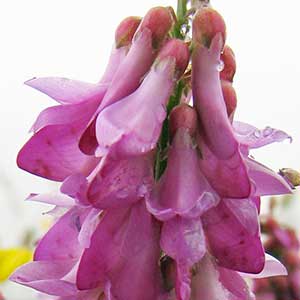Hedysarum occidentale
Hedysarum
western hedysarum, western sweet-vetch
hedysarum, sainfoin, sweetvetch
decumbent to erect, (1.2–)2–9.5 dm.
decumbent to erect or ascending, solid, terete, pubescent, hairs basifixed;
from branching subterranean to superficial caudex.
3.5–23 cm;
stipules 10–17 mm;
leaflets 9–19, blades lanceolate to ovate, elliptic, or oblong, 5–40 × 3–16 mm, veins conspicuous, surfaces usually pubescent, rarely glabrous adaxially.
alternate, odd-pinnate;
stipules present, slightly adnate to petiole base, ± connate-sheathing, often suffused with purple, lanceolate, simple or bidentate, scarious; petiolate, petiole much shorter than or subequal to blade;
leaflets 5–27, opposite or alternate, petiolulate, blade margins entire, surfaces mostly pubescent, sometimes glabrous adaxially.
10–50-flowered, axis 4–25 cm in fruit;
bracts 1–4 mm.
5–60-flowered, axillary, racemes, sometimes subcapitate;
bracts present, 1 per flower;
bracteoles usually 2.
(3–)6–15 cm.
1–3.5 mm.
usually declined at anthesis;
calyx 3.5–11 mm;
tube 3–9 mm, puberulent;
lobes subulate to triangular, 0.5–2 mm, equal or nearly so;
corolla usually lavender-pink or lilac- to pink-purple, rarely white, 16–25 mm;
wing auricles connate, linear, nearly equal or equal to claw.
papilionaceous;
calyx campanulate, lobes 5;
corolla usually pink, pink-purple, lavender-pink, red-purple, lilac, lilac-purple, or yellow, rarely white, keel much exceeding wings, somewhat longer than banner, broadly truncate, apex prominent, oblique;
stamens 10, diadelphous;
anthers dorsifixed;
ovary enclosed in staminal sheath;
style glabrous.
loments, stipitate, pendulous to spreading, compressed, straight, narrowly ellipsoid, indehiscent (breaking transversely), constricted into 1–8, 1-seeded segments, glabrous or pubescent, rarely with processes.
1 per segment, brown, flattened, reniform-ovoid, glossy.
segments (1 or)2–5, 7–14.5(–18) × 5.6–10.2(–11) mm, margins conspicuously winged, prominently reticulate, pubescent or glabrous.
= 7.
Hedysarum occidentale
Hedysarum
Varieties 2 (2 in the flora).
(Discussion copyrighted by Flora of North America; reprinted with permission.)
Species ca. 50 (4 in the flora).
(Discussion copyrighted by Flora of North America; reprinted with permission.)
1. Leaflet blades usually 2–4 times longer than wide, not or rarely thickened, not especially deciduous; flowers 16–22 mm, usually lilac- to pink-purple, rarely white; widespread. | var. occidentale |
1. Leaflet blades mostly 1–2 times longer than wide, becoming thickened, early deciduous; flowers (17–)20–25 mm, pale lavender-pink; w Colorado, e Utah. | var. canone |
1. Leaflet blade veins obscure; loment margins moderately or not winged; calyx lobes subequal to markedly unequal in size; wing auricles distinct, blunt, shorter than claw. | H. boreale |
1. Leaflet blade veins conspicuous; loment margins narrowly or conspicuously winged; calyx lobes equal or nearly so; wing auricles connate, linear, nearly equal or equal to claw. | → 2 |
2. Flowers 10–19(–22) mm (when greater than 16 mm, then from north of 50th parallel), corollas usually lilac- to pink-purple, rarely white; loment segments 5.5–12 × 3.5–6 mm, margins narrowly winged; leaflet blades lanceolate to oblong, elliptic, or lanceolate-elliptic. | H. alpinum |
2. Flowers (14–)16–25 mm, corollas usually yellow to pale yellow, or shades of pink or purple, rarely white; loment segments 7–14.5(–18) × 5.5–10.2(–11) mm, margins conspicuously winged; leaflet blades lanceolate to ovate, elliptic, oblong, or lanceolate-oblong. | → 3 |
3. Corollas yellow to pale yellow, 14–20 mm; loment segments 5.5–9 mm wide, glabrous. | H. sulphurescens |
3. Corollas usually lavender-pink or lilac- to pink-purple, rarely white, 16–25 mm; loment segments 5.6–10.2(–11) mm wide, pubescent or glabrous. | H. occidentale |


